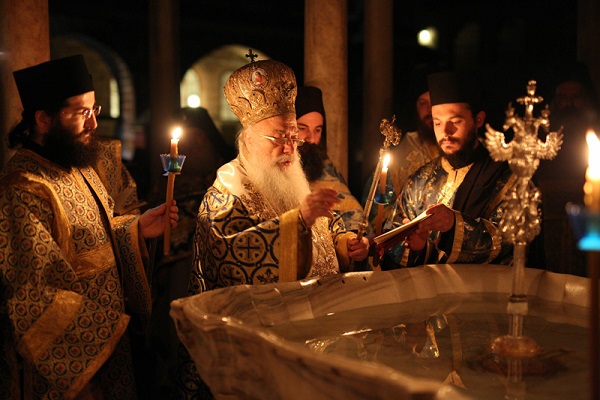The Great Blessing of the Waters
5 January 2017What is the Blessing of the Waters, and what’s the difference between the Great and the Small? The Great as compared to the Small? The Blessing of the Waters belongs to the category of ‘sacramental rites’. We call services ‘sacramental’ when Divine Grace is imparted through them, invisibly, through perceptible gestures and signs. Such services were not instituted by Christ, however, nor are they necessary to salvation, as are the sacraments themselves.
As regards the number seven, there is no mention of this in the Church Fathers. They consider any and every form of ritual which is performed by canonical celebrants for the sanctification and salvation of the faithful to be a Sacrament.

Every holy action and ritual in the Church is a sacrament and every sacrament is great, as is the mystery of the Church itself, because every sacramental act in the theanthropic organism of the Church is in an organic and vital relationship with the central mystery of the Church, Christ the God/Man.
‘The Great Blessing of the Waters’ is the name we give the service which is celebrated twice a year (5 and 6 January) in commemoration of the baptism of Christ in the River Jordan. The Small Blessing of the Waters is usually held in churches on the 1st of each month and at various other public events (the foundation of a house, the opening of a shop, the inauguration of public works and so on). It’s a mistake to think that the blessing on the eve of Theophany is the Small Blessing and that of the day itself is the Great. The service of the Great Blessing of the Waters is held on both these days.
In the Early Christian Church, the blessing of the water at Theophany was for the baptism of the catechumens, after the faithful had drawn off a portion as a blessing. This is clear from the hymn we sing at the baptism service and at the Divine Liturgy on the feast of Theophany: ‘As many as have been baptized in Christ…’.
The celebration of the Great Blessing of the Waters on the eve of Theophany is a relatively recent innovation, in order to serve the needs of the faithful. It’s also linked to the custom of priests visiting the houses of their parishioners to sprinkle holy water on the eve of the feast.
The sanctification of the waters is effected through the prayer: ‘You are great, Lord…’ and the blessing by the right hand of the celebrant (bishop or priest) and the prayer: ‘Therefore, merciful King, be present now through the descent of your Holy Spirit, and sanctify this water’. It’s also a mistake to believe that the sanctification occurs at the moment the Precious Cross is submerged in the water and we sing the dismissal hymn of the feast: ‘When you were baptized in the Jordan, Lord…’. The submersion of the Cross is a later addition and was introduced to depict the Lord’s baptism in the Jordan in a more graphic manner.
The sanctification prayer at the Great Blessing (‘Make it a source of incorruption, a gift for sanctification, a redemption for sins, a remedy for maladies, a ruination for demons, unapproachable to the adverse powers, replete with angelic power, so that all who drink and receive it may have it for the purification of their souls and bodies, for the healing of sufferings, for the sanctification of homes and for all appropriate benefit’), makes it clear that ‘through consumption and sprinkling’, we believe that ‘we are sanctified and purified of our sins’. It protects us from the attacks of the devil, heals our sicknesses and grants us health. With it we sanctify our houses, and all animal and plant life. It’s appropriate and beneficial for every occasion. Through the Grace of the Holy Spirit, it acts upon all things animate, and even inanimate, transforming and sanctifying them. It cleanses and sanctifies His faithful servants and the whole of nature.
According to folk tradition, holy water expels the evil spirits, ‘the goblins’. This is because it’s considered to be their worst nightmare, since it combines the purifying power of water with the divine power of the Cross, which has been submerged in it.






